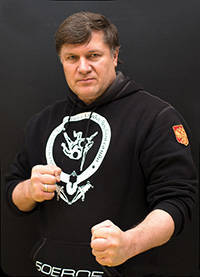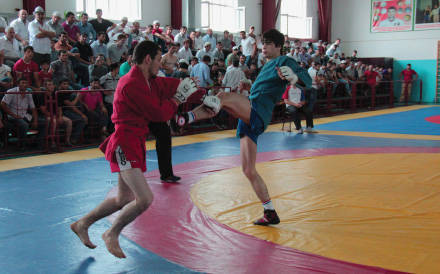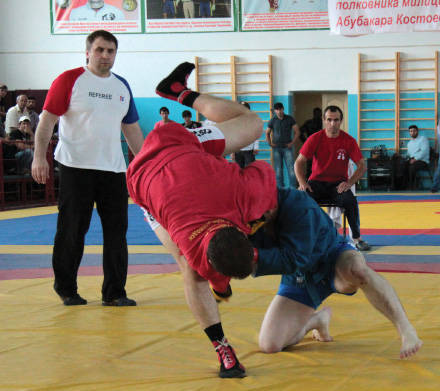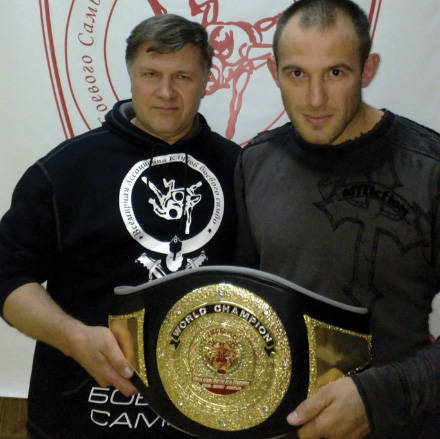Combat Sambo: the secrets of rational technology
 The applied section of combat sambo is less known to the general public than the sports one, but partly because of this and more interesting. It is the applied section that can give stunning and stunning answers to "street" questions about smoking and place of residence. A well-recognized specialist in combat sambo - Valery Volostnykh, a recognized master, well known to anyone interested in this kind of martial arts, can probably highlight the actual topic of street self-defense in a qualified and comprehensive way.
The applied section of combat sambo is less known to the general public than the sports one, but partly because of this and more interesting. It is the applied section that can give stunning and stunning answers to "street" questions about smoking and place of residence. A well-recognized specialist in combat sambo - Valery Volostnykh, a recognized master, well known to anyone interested in this kind of martial arts, can probably highlight the actual topic of street self-defense in a qualified and comprehensive way.- Usually on the street are mobbed. What answer does combat sambo give to the “usual questions” of the street punks?
- Even Kharlampiev said that you can run. The whole group can not run with one speed, in a row or in a semicircle - someone rushes forward. You work with him, and it turns out to be a fight, not a fight with everyone. One quickly neutralized, and continue to run. Someone else will take the lead - and him. And so on. The crowd stretches into a line on the run. It's bad if you are surrounded. Then you have to stand with your back to the wall or something like that. The real situation is not like a movie. Especially if the attackers have some level of training. Miracles do not happen. Non-contact fights, shown on the stage, will not work. Otherwise, in serious situations, this would have been used long ago: by capture groups, special forces. In the "Nord-Ost" used gas and firearms weapon, no contactless melee fighting was not. Weapons are used in all armies of the world, but not miracle variety shows.
- That is, the truth criterion is a practical result?
- Of course, but how is it different? In the case of contactless combat, the result is usually not. Results on the stage are demonstrations, as in aikido. No validation in practice.
- By the way, as a professor in the department of physical education and sports, tell me: should a fighter understand the theory of sports science?
- The coach should know more about the nuances. This is what distinguishes him from an athlete: an athlete from any kind of martial arts can simply show his best, favorite trick or some kind of acquired tactics. And the coach should give the school, show not his own, but a fan, various techniques. It was Kharlampiev who said: "Do not do it like me." And from this variety of techniques that a student masters, as a result of practicing the techniques, a circle of favorite techniques crystallizes - this is if we are talking about sports. And based on this, a dynamic stereotype arises in the subconscious. The person automatically makes his crown elements at a high level. He can sometimes win only with the help of this small circle of tricks, formed as a result of a lot of work.
Well, if we are talking about the application section, there the circle of methods is even narrower. Varieties of technology are not needed - because a person should not have a problem of choice. In an extreme situation, everything should be fast - this is how an applied combat differs from a sports one. An applied scrum usually occurs unexpectedly, in extreme conditions. In sports, we approximately know what and how. Stress can occur only because the titles of the opponent (if you know about them) or the very atmosphere of the competition put pressure on the psyche. For the rest, about everything is the same - opponents of the same level come to the carpet. This does not happen to the world champion or deserved master of sports confronted newcomer.
On the street, we do not know who goes against us. Fear comes from obscurity. At the same time on the street is usually a big attack on the small. Or a few opponents - two or three people, which also puts pressure on the psyche. But it also happens that the attacker has a weapon: a brick, a stick, a knife, and even a pistol. It also increases the level of stress in the one being attacked. Therefore, on the street it is desirable to work quickly.
And if a problem of choice arises in my head at this moment, we will begin to remember which tricks we know, how to put a hand, how to grab - we will miss precious time. As long as a person remembers, he will already be given a club on the head.
- Valery Valentinovich, so what to do in case of a real threat? And how does a master of combat sambo act in such a stressful situation? What he chooses?
- When the circle of rational methods is narrow, then there is no problem of choice. In the application section, we do not give a lot of equipment - a person will have a mess in his head, and there may be little time for training. Therefore, we give only the most rational, most-needed, nothing superfluous. A person should not be confused in the head, only the principles: natural movements, maintaining balance, leaving the line of attack, entering the melee zone, attacks on vulnerable zones, the combination (serial) principle. Serial - it means to bet not on one hit, but on the series. If you draw an analogy with a weapon, it is not a single shot from a pistol or a cannon, but a volley of a rocket launcher when a whole square is covered. So even aim almost not necessary. You can not hope for one hit and wait for the opponent to fall, as in films about karate: the enemy may be in a bulletproof vest, the hand may slip a little. There should always be a safety margin - and the principle of seriality gives it. Something did not pass, you do not care - just four or five movements! Everything is continuous. There is also the principle of responsiveness, a sense of action. And the psyche must be trained. For example, they took my hand, immediately leaving the line of attack, do not expect something there, do not think. And from the line of a possible attack - even if it really is not. But she can be!
 - There is no time to meditate here ...
- There is no time to meditate here ...- Of course. If you start thinking, you will miss the moment, and when there will be an attack, you don’t have time to react. Therefore, only you took the hand, you are already on the side or behind the back of the enemy. And you already have an advantage. Let him not even beat, but he has already shown aggression. And you can destroy it, injure it or delay it - depending on the task.
Therefore, when studying the application section, everyone is given the same narrow circle of technical elements. Each athlete empirically, on the basis of practice, competitions comes to some movements that he can do best. And this circle of techniques is polished as if by itself. And to create this circle, you need to look not at someone's crown tricks, but to study the classical school: make throws through the thigh, through the back, the mill, through the head, hooks, hooks, curl and so on. And from the variety you take your elements, something you will like more, something will be better obtained depending on the physique and psyche. And at the expense of this circle of your tricks, which will be great for you, you will partly win - if we are talking about technology. In addition, there are physical qualities, volitional, psychological preparation.
- But how to find this "your" complex of receptions? Look at the masters? Copy their movements?
- If we again started talking about theory, then not a single athlete, even a champion, who phenomenally owns some tricks, can “mirror” his techniques to a student. Everyone does it their own way. In general, you need to give the whole complex of technical elements, and everyone will take his own from it. The trainer, of course, can advise, determine the most acceptable techniques and technical elements for the student. But do not recommend: "I do this, repeat after me." This is the Eastern way. There students have no critical perception, just blind copying. And many, even sensei, cannot explain why they perform this or that element in such a way. We have a different mentality, we cannot, without hesitation, repeat how Robots — showed, and forward.
The approach to learning should be critical: you can doubt, ask questions. There are valuable things in wrestling techniques coming from time immemorial, but there is also “garbage” that needs to be swept. And we thoughtlessly take it all together. What for? And we live here, and not in the same Japan. I believe that everything must be adapted to our soil. Russia is in the center of the continent: between north and south, west and east. All the ways converge here. We must take all the best, and not only in martial arts.
Do not be shy to learn from someone, if we see that it is rational, interesting, correct. I myself did not hesitate to engage in N. Borisov and V. Vyazmin (dharma-mage wrestler).
- That is, nothing can be taken on faith, one should always ask: what is it for, what is the purpose?
- And how? This is the essence of scientific knowledge. In the conditions of war, such an approach is inapplicable, since independence will affect discipline. And in training conditions, of course, you need to think. Show me some tricky movements - what are they based on? But each coach has his own approach, his own method. This is a question of pedagogy. You can immediately explain everything thoroughly. It is possible then. In pedagogy, there is the so-called “problem method”: to create a problem so that the person himself comes to its solution. That is, you do not chew everything on him, you do not tell him to the end, and the person himself comes to a decision. Valuable method. And the understanding of the subject matter in this case is more profound.
- You mentioned the “problem method”. Does he have to do with the stress method, when the student is given the task and the conditions are created that he is forced to fulfill it?
- “Problem method” is less suitable for applied training, because first of all we train responsiveness - basically the problem is this. It is necessary to react instantly, without being frightened. "Problem method" is more suitable for sport, as it is aimed at the gradual awareness of some things, mostly technical elements. The person slowly comes to why, in that situation, it’s better to sit down, for example. For applied training, the main thing is to work well. There is no time there. For example, gangsters will fly into this room - they must immediately react, otherwise they will be jabbed with a "pike" or shot from a pistol. The end.
And here it is necessary for the psyche to work properly: to immediately dodge, hide, make a roll over the column, otherwise you will be flashed with a queue from a machine gun.
 - And how to build a methodology for preparing an applied section of combat sambo for each particular person? Where to begin? Share the secrets.
- And how to build a methodology for preparing an applied section of combat sambo for each particular person? Where to begin? Share the secrets.- Ideally, everything should be harmonious, and it is necessary to add to the applied training and sports: athleticism, fights. In my opinion, this is how it should be in every normal school. It is clear that everyone will not be equally involved and own anything, as people are all different. There are fighters, ready by nature. There are people who do not need to psychologically prepare for skydiving - they can jump without problems. And there are, on the contrary, those who cannot overcome the instinct of self-preservation. No need to focus on the first or second. Each by nature has its own ceiling. Most can jump after training.
But we are talking about "school." In it, besides sports, there must be good special training. But here it is looking at what goals. If, for example, it is a commando, he needs to solve his functional tasks. We will work with him on these issues and give less competitive practice. The same who prepares for the World Cup, on the contrary, needs only an initial degree of applied training.
But special forces are also different with different tasks. In general, if roughly divided, there are three of them: destruction, injury without destruction, detention without injury. Although they are intertwined. And the psyche must be prepared accordingly. For example, if the task is destruction, then there should be nothing else in the head. Or you - or you. It happens that, according to the law, a fighter has the right to injure an enemy, but he cannot kill - the same riot police, for example. Thirdly, detention without injury is the most difficult task. One on one with the enemy this task is difficult to accomplish, usually it is solved by two. Cope alone - great art, you need to head for the skill superior to the opponent.
There are also narrower tasks: guards, bodyguards, marine special forces, GRU special forces, FSB special forces - Alpha, Vympel groups and others. Each unit has its own nuances.
- Let's talk more about the stress method.
- There is also stress in sports, but there is a doctor there, a judge, and no one is interested in your death. In a real situation, there is only an enemy who can cripple you or even kill you. And if you are frightened, then your skills may not work.
Training in the application section is carried out faster, because there is no sense in preparing a specialist for ten years, so that he can then act. Due to the special methods of combat sambo, the preparation time is reduced.
For example, first we study knife protection. We studied the trajectory - we increase the speed. First, we work with a plastic bottle, then with a wooden dummy, then with a metal knife or the equivalent of a stick or knife. Then with a knife present.
Therefore, there are special tasks. I stand with my back to the enemy, clapping sharply over a clap or other signal, he already hits me. I have to defend myself. Even if the weapon is not real, for the body it is already stress. Already harder to work. This is the training for surprise. Gradually add the problem of choice. At first, I know that there will be only one blow with a knife or a stick — on top, for example. Then he can hit either from above or from the side. And then, in general, can strike with a stick, maybe with a knife, or maybe with a foot. I do not know that. Or will attack a few people. And when I turn, I must instantly react. This is the training of the psyche. But such exercises can not be carried away. There are limitations, the psyche, too, must be protected. Did a certain number of repetitions - take a break.
Further exercise becomes even more difficult. We stand face to face at a distance of two meters. The partner makes a somersault towards me, just jumps up - I immediately hit. At first, he knows what, and in the following stages he no longer. A knife, a fist, a foot, a stick — this should not excite him at this stage. Instantly respond, leave the line, pull the head off the shoulders and finish it off.
If we are talking about detention, then, of course, not put your head from your shoulders, but put the enemy himself on the ground and put his hand behind his back.
Then the training again becomes more complicated: the partner has his back to me. I push him in the back, he rolls up. I follow him. He jumps up, turns around - at this time I attack.
Or, for example, as I coached Chopov: a fighter leaves the coaching room or from the "rocking chair" and on the window sill a man with a club jumps and immediately hits. And because of the door another with a gun. And the third is attacking with a kick. The fighter knows that there will be an attack, but what and how - no.
We simulate situations, gradually complicating them, and the person is already beginning to navigate. And the guards handed over the tests to repel the attack. If not, it worked, then the test is not set. And there are also certain criteria: he should not go into the seizure, spending precious seconds on it. Because if you grabbed one - well, but there are two of them there. Mistake! One can still grapple with, somehow fight, but not with a group. Therefore, pure fighters have to relearn. In application training captures are not needed except in some cases. It is better to do the grip of the elbow, so as not to constrain yourself. And, of course, we need percussion technique.
- Grabbing someone, we ourselves neutralize our own limbs, and we cannot defend against two or three people?
- Yes. Capture is simply irrational. A wrestler can defend himself if he has a high level of training, but we know nothing about those who will attack. And we need a safety margin. Therefore, it is better to act rationally. We in our applied training deny even a turn through the back, because in general it is impossible to turn our back to the enemy. Suddenly something will not work - even a high-class athlete does not always get everything. In the applied preparation technique is slightly different. Of course, we use some kind of wrestling elements, but very metered.
For example, the wrestler threw beautifully over his back from his knees, and the second approached from behind and hit with a brick. Therefore, it is impossible to fall on the street, you cannot kneel down for a throw, you cannot turn your back, you have to defend one opponent from others as much as possible and see the whole situation. The technique allows, making a reception, to see that you are behind your back - what if someone had already set up a gun. And you have a chance to hide behind the enemy or to make somersaults - if there is where. At least there is a chance. If you are "tied up" with one opponent, then you can not see anything at all.
 - Are kicks applicable in a fight with a group?
- Are kicks applicable in a fight with a group?- Of course! But not high level shots. Shin, knee, groin. So safer. To perform strikes at a high level, you need a high level of skill. There are few people who have gained kicks to the extent that they can beat like in the movies. In the same sport, professionals twist their feet a little. But for us the principle of maintaining balance is very important. With high kicks, there is a danger of losing balance.
- There is an opinion that in a battle with a group you only need to attack, and not defend.
- Situations are different. You cannot know whether there will be an attack or not. Sometimes you need to attack first if you feel that the fight is inevitable. Because so immediately you get an advantage. It is advantageous to attack the leader of the group, as it may psychologically suppress others who may refuse to fight. But it is impossible to give recommendations for all occasions. The element of unpredictability is always present. It is necessary to train, learn rational things, learn to feel, prepare the psyche, have sports skills - all this will give a certain safety margin. Nobody can give a guarantee to anyone. The champion, the cool commando ... When you need it, everyone is cleaned - two kilometers away with an optical sight.
Therefore, I am here talking only about those cases where we can really resist an attack. In training, we prepare people so that at the right moment the subconscious mind works and the person is able to give an instant rebuff to a bold and strong opponent.
Information